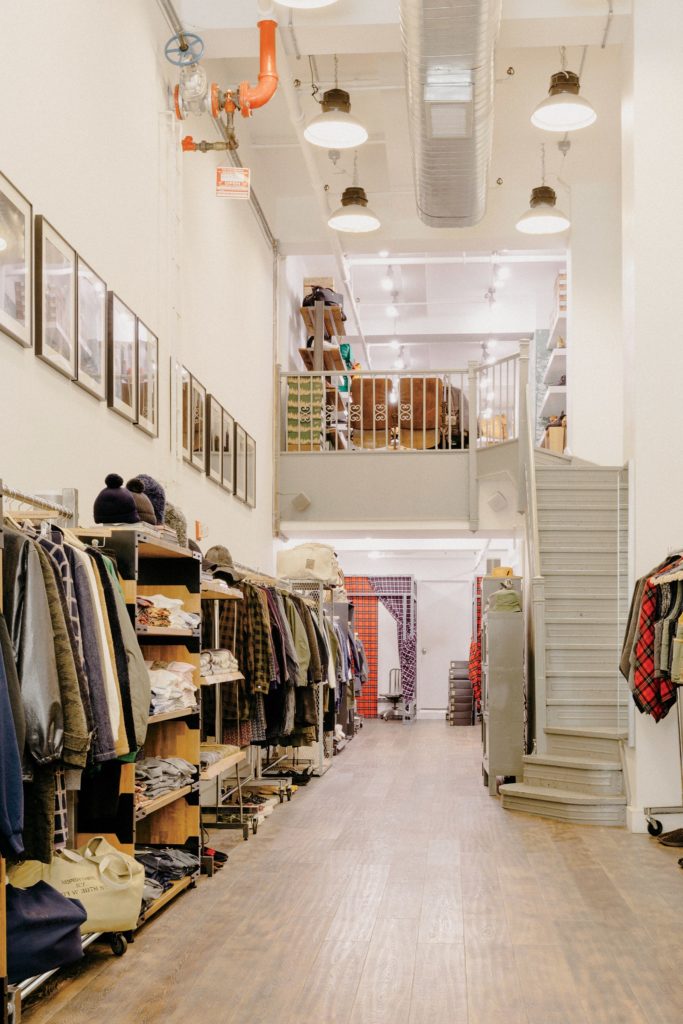PHOTOGRAPHY BY RYAN LOWRY
At Nepenthes, Daiki Suzuki and his team are resisting the mall-ification of New York City with a Garment District boutique where the clothes are made upstairs. Fans from around the world make the trek to the destination shop, but the future of the neighborhood is uncertain.
New York’s Garment District is a dense commercial neighborhood in the heart of Manhattan where the American fashion industry did much of its business for decades. At one time, all aspects of apparel production went through here, from design to manufacturing, sales, and distribution. In the 1950s, you couldn’t walk down a block between Seventh and Ninth Avenues, from 34th Street to 42nd Street, without being nearly run down by a renegade rack of clothing or clobbered by a swinging bolt of fabric. Hundreds of thousands of laborers were employed to do every clothes-making job you can imagine—cutting patterns, stitching buttonholes, selling textiles, even making the needles used by sewing machines. The Garment District was a center for both industry and culture, a rare place where commerce and creativity met, and it became home to American fashion institutions like Calvin Klein, Donna Karan, and Oscar de la Renta.
By the 1980s, as apparel production moved overseas, just 30,000 manufacturing jobs were left in the Garment District. That number has continued to dwindle as gentrification and frenzied Manhattan development intensified the displacement of factories to make room for new buildings and more lucrative industries. (By one count, there are 37 new hotels currently planned for the area.) Today the Garment District has only about 5,000 jobs left, and Mayor Bill de Blasio’s plan to entice remaining businesses to a “Made in New York Campus” in Brooklyn’s Sunset Park neighborhood is under way.
When Daiki Suzuki launched Engineered Garments in 1999 as a line of pants out of a store in SoHo, the soft-spoken designer relied on the trim shops, cutting rooms, and sewing factories of the Garment District (and the colorful characters who ran them) to supply him with the materials and knowledge he needed to get off the ground, and he developed relationships with the folks in charge of the factories. In 2008, Suzuki moved his operation, Nepenthes New York, to a 38th Street office in the Garment District, downstairs from one of the company’s most important factory partners. Together with his production manager, Todd Killian, who has been with him since day one, he continued to develop a unique rapport with factories that has proven beneficial for all involved.
“It’s a two-way street,” Killian says of the company’s relationship with the factories. “We cannot do it without them.” Everything Engineered Garments produces is made within a few blocks of the office. Suzuki notes that the remaining factories are there because they’re very good at what they do, and the clothes he designs require equipment and skills that go far beyond what’s typical for making menswear. The brand’s work shirt, for instance, is assembled using five different types of sewing machines—and not the kind that just any sewer can operate and operate well. “The guy who makes our shirts, he doesn’t want to work with anyone else,” Killian says. “He has no desire. He gave up when he saw the kind of business that we do.” Killian says he makes a point to always pay on time, to never nickel-and-dime the factory owners for lower costs, and not to rush. The quality of the product is better that way, and both parties are happier. Suzuki says he has purchased machines in partnership with the factories so that he can get the unique work he needs, and the factories have an investment from him that goes beyond another order. It’s not just a business relationship; it’s a value system.
Continue to read at https://www.gq.com/story/nepenthes-new-york-garment-district-daiki-suzuki
Credit to GQ.com




